Book contents
- Politics in the Roman Republic
- Key Themes in Ancient History
- Politics in the Roman Republic
- Copyright page
- Contents
- Acknowledgements
- Abbreviations (Authors and Works)
- Introduction
- Chapter 1 Senatus Populusque Romanus
- Chapter 2 Leaders and Masses in the Roman Republic
- Chapter 3 Consensus and Competition
- Bibliographic Essay
- Bibliography
- Index
- References
Bibliography
Published online by Cambridge University Press: 16 March 2017
- Politics in the Roman Republic
- Key Themes in Ancient History
- Politics in the Roman Republic
- Copyright page
- Contents
- Acknowledgements
- Abbreviations (Authors and Works)
- Introduction
- Chapter 1 Senatus Populusque Romanus
- Chapter 2 Leaders and Masses in the Roman Republic
- Chapter 3 Consensus and Competition
- Bibliographic Essay
- Bibliography
- Index
- References
Summary

- Type
- Chapter
- Information
- Politics in the Roman Republic , pp. 176 - 197Publisher: Cambridge University PressPrint publication year: 2017



